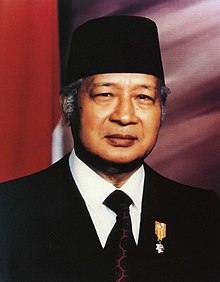revenues, crumbling infrastructure, factories operating at minimal capacity, and negligible investment. Following President Sukarno's downfall in the mid-1960s, the New Order administration brought a degree of discipline to economic policy that quickly brought inflation down, stabilized the currency, rescheduled foreign debt, and attracted foreign aid and investment. (See Berkeley Mafia). Indonesia was until recently Southeast Asia's only member of OPEC, and the 1970s oil price raises provided an export revenue windfall that contributed to sustained high economic growth rates, averaging over 7% from 1968 to 1981.[9] High levels of regulation and a dependence on declining oil prices, growth slowed to an average of 4.3% per annum between 1981 and 1988. A range of economic reforms were introduced in the late 1980s including a managed devaluation of the rupiah to improve export competitiveness, and de-regulation of the financial sector,[10] Foreign investment flowed into Indonesia, particularly into the rapidly developing export-oriented manufacturing sector, and from 1989 to 1997, the Indonesian economy grew by an average of over 7%.[11][12]
GDP per capita grew 545% from 1970 to 1980 as a result of the sudden increase in oil export revenues from 1973 to 1979.[13]
[edit] Asian Financial Crisis
The Asian Financial Crisis that began to affect Indonesia in mid-1997 became an economic and political crisis. Indonesia's initial response was to float the rupiah, raise key domestic interest rates, and tighten fiscal policy. In October 1997, Indonesia and the International Monetary Fund (IMF) reached agreement on an economic reform program aimed at macroeconomic stabilization and elimination of some of the country's most damaging economic policies, such as the National Car Program and the clove monopoly, both involving family members of President Suharto. The rupiah remained weak, however, and President Suharto was forced to resign in May 1998. In August 1998, Indonesia and the IMF agreed on an Extended Fund Facility (EFF) under President B.J Habibie that included significant structural reform targets. President Abdurrahman Wahid took office in October 1999, and Indonesia and the IMF signed another EFF in January 2000. The new program also has a range of economic, structural reform and governance targets.The effects of the financial and economic crisis were severe. By November 1997, rapid currency depreciation had seen public debt reach US$60 bn, imposing severe strains on the government's budget.[17] In 1998, real GDP contracted by 13.7%. The economy reached its low point in mid-1999 and real GDP growth for the year was 0.3%. Inflation reached 77% in 1998 but slowed to 2% in 1999.
The rupiah, which had been in the Rp 2,600/USD1 range at the start of August 1997 fell to 11,000/USD1 by January 1998, with spot rates around 15,000 for brief periods during the first half of 1998.[18] It returned to 8,000/USD1 range at the end of 1998 and has generally traded in the Rp 8,000–10,000/USD1 range ever since, with fluctuations that are relatively predictable and gradual.
[edit] Post Suharto
In late 2005 Indonesia faced a 'mini-crisis' due to international oil prices rises and imports. The currency reached Rp 12,000/USD1 before stabilizing. The government was forced to cut its massive fuel subsidies, which were planned to cost $14 billion for 2005, in October.[19] This led to a more than doubling in the price of consumer fuels, resulting in double-digit inflation. The situation had stabilized, but the economy continued to struggle with inflation at 17% in 2005.For 2006, Indonesia's economic outlook was more positive. Economic growth accelerated to 5.1% in 2004 and reached 5.6% in 2005. Real per capita income has reached fiscal year 1996/1997 levels. Growth was driven primarily by domestic consumption, which accounts for roughly three-fourths of Indonesia's gross domestic product. The Jakarta Stock Exchange was the best performing market in Asia in 2004 up by 42%. Problems that continue to put a drag on growth include low foreign investment levels, bureaucratic red tape, and very widespread corruption which causes 51.43 trillion Rupiah or 5.6573 billion US Dollar or approximately 1.4% of GDP to be lost on a yearly basis.[20] However, there is very strong optimism with the conclusion of peaceful elections during the year 2004 and the election of the reformist president Susilo Bambang Yudhoyono.
The unemployment rate in February 2007 was 9.75%.[21] Despite a slowing global economy, Indonesia’s economic growth accelerated to a ten-year high of 6.3 percent in 2007. This growth rate was sufficient to reduce poverty from 17.8 to 16.6 percent based on the Government’s poverty line and reversed the recent trend towards jobless growth, with unemployment falling to 8.46 percent in February 2008.[22][23] Unlike many of its more export-dependent neighbors, it has managed to skirt the recession, helped by strong domestic demand (which makes up about two-thirds of the economy) and a government fiscal stimulus package of about 1.4 percent of GDP, announced earlier this year. After India and China, Indonesia is currently the third fastest growing economy in the Group of Twenty (G20) industrialized and developing economies. The $512 billion economy expanded 4.4 percent in the first quarter from a year earlier and last month, the IMF revised its 2009 forecast for the country to 3-4 percent from 2.5 percent. Indonesia enjoyed stronger fundamentals with the authorities implemented wide-ranging economic and financial reforms, including a rapid reduction in public and external debt, strengthening of corporate and banking sector balance sheets and reducing bank vulnerabilities through higher capitalization and better supervision.[24]

No comments:
Post a Comment